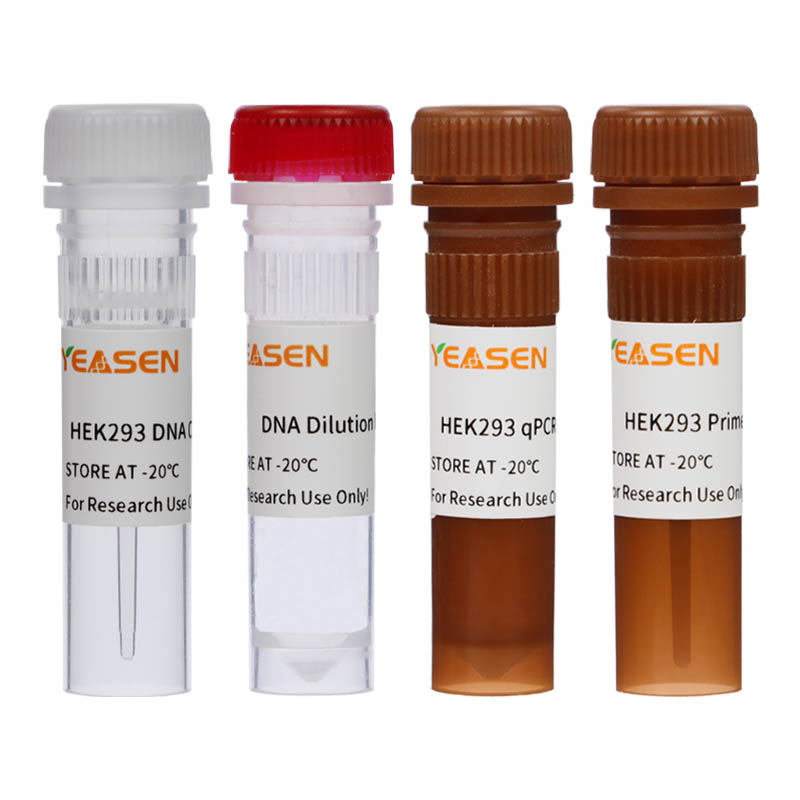HEK293 Host Cell DNA Residue Detection Kit
Product Description
HEK293 Host Cell DNA Residue Detection Kit is used for the quantitative analysis of HEK293 host cell DNA residuce in intermediate samples, semi-finished and finished products of various biological products.
This kit adopts Taqman fluorescent probe and the polymerase chain reaction (PCR) method, which has fg level minimum detection limit and can specifically and quickly detect the residual HEK293 cell DNA. The combined use of UDG enzyme and dUTP can eliminate the contamination caused by amplification products. The kit needs to be used together with the the Residual DNA Sample Preparation Kit (Cat# 18461ES).
Product Components
|
Category |
Components No. |
Components Name |
Cat#/Size |
|
|
41302ES50 (50T) |
41302ES60 (100T) |
|||
|
Part I |
41302-A |
HEK293 qPCR mix (UDG plus) |
0.8 mL |
1.6 mL |
|
41302-B |
HEK293 Primer&probe mix |
200 μL |
400 μL |
|
|
41302-C |
DNA Dilution Buffer |
2×2 mL |
4×2 mL |
|
|
Part Ⅱ |
41302-D |
HEK293 DNA Control (30 ng/μL) |
25 μL |
50 μL |
[Notes]: This kit does not contain ROX reference dye. If you need to add ROX reference dye to the Real Time PCR thermal cycler you are currently using, it is recommended that you purchase 50× ROX Reference Dye (Cat#10200ES) from our company.
Shipping and Storage
1. Part I is shipped on dry ice and stored at -20°C for 1 year
2. Part II is shipped on dry ice and stored at -80°C for 1 year.
3. After receiving the goods, please check whether the two components of Part I and Part II are complete, and store them in the corresponding storage temperature immediately.
Cautions
1. Please read this manual carefully before using this reagent, and the experiment should be standardized, including sample handling, reaction system preparation and sample addition.
2. Adding samples and preparing solutions is best done on ice.
3. Ensure that each component is fully vortexized and centrifuged at low speed before use.
4. For your safety and health, please wear lab coats and disposable gloves for operation.
5. This product is for research use ONLY!
Applicable instrument models
Include but not limited to:
Bio-Rad: CFX96 Optic Module.
Thermo Scientific: ABI 7500; ABI Quant Studio 5; ABI Step OnePlus.
Using Instruction
1. HEK293 DNA Standard dilution and Standard curve preparation
The HEK293 DNA Control was gradient diluted using the DNA Dilution Buffer provided in the kit, and the dilution concentration is 300 pg/μL, 30 pg/μL, 3 pg/μL, 300 fg/μL, 30 fg/μL.
See detailed instructions below:
1.1 Thaw the HEK293 DNA control and DNA dilution buffer on ice. After completely thawed, vortex gently to mix, and centrifuge at low speed for 10 secs.
1.2 Take out six clean 1.5 mL tubes, marked with 3 ng/μL, ①, ②, ③, ④, ⑤.
1.3 Add 90 μL DNA dilution buffer and 10 μL HEK293 DNA Control to the 1.5 mL tube labeled 3 ng/μL, dilute to 3 ng/μL. Mix and then centrifuge for 10 secs. Subpackage the diluted DNA standard and it can be stored in the short term (no more than 3 months) at -80°C.Please avoid repeated freeze-thaw.
1.4 Add 90 μL DNA dilution buffer into other tubes, then follow the below procedure for the serial dilutions.
|
Tube |
Dilution Ratio |
Standard concentration |
|
① |
10 μL 3 ng/μL+90 μL DNA Dilution Buffer |
300 pg/μL |
|
② |
10 μL ①+90 μL DNA Dilution Buffer |
30 pg/μL |
|
③ |
10 μL ②+90 μL DNA Dilution Buffer |
3 pg/μL |
|
④ |
10 μL ③+90 μL DNA Dilution Buffer |
300 fg/μL |
|
⑤ |
10 μL ④+90 μL DNA Dilution Buffer |
30 fg/μL |
[Notes]:
1. Three replicate wells are required for each concentration.The detection range is 30 fg/μL-300pg/μL and this range can be expanded if required.
2. To reduce the number of repeat freeze-thaw and avoid contamination, it is recommended to store the DNA control in aliquots at -80°C for the first time.
3. Once thawed, DNA dilution buffer could be stored at 2-8°C for 7 days, if not used for a long time, please store at -20°C.
4. Make sure the template is completely mixed, gently shake the mixture for 15 secs to 1 min for each gradient dilution.
2. Extraction Recovery Control (ERC) preparation
Set the concentration of HEK293 DNA in ERC as needed (the ERC sample was prepared with 3 pg/μL DNA as an example), as follows:
2.1 Add 100 μL test sample into a clean 1.5 mL tube, then add 10 μL 3pg/μL HEK293 DNA Standard (③) and mix well, marked as ERC.
2.2 Perform the DNA extraction of ERC sample together with the test samples to prepare the purified ERC sample.
3. Positive Control Sample (PCS) preparation (Optional)
Set the concentration of HEK293 DNA in PCS as needed (the PCS was prepared with 3 pg/μL DNA as an example), as follows:
3.1 Add 100 μL 3 pg/μL HEK293 DNA Standard (③) into a clean 1.5 mL tube, then marked as PCS.
3.2 Perform the DNA extraction of PCS together with the test samples to prepare the purified PCS.
4. Negative Control Solution (NCS) preparation
Set the negative control in the experiment, the specific operation steps are as follows:
4.1 Add 100 μL sample matrix (or DNA dilution buffer) into a clean 1.5 mL tube, then marked as NCS.
4.2 Perform the DNA extraction of NCS sample together with the test samples to prepare the purified NCS sample.
5. No Template Control (NTC) preparation
Set the no template control in the experiment, the specific operation steps are as follows:
5.1 NTC requires no sample pretreatment, and can be configured at the stage of qPCR detection of residual DNA content.
5.2 The NTC sample in each tube or well is 20 μL Mix (i.e. 16 μL HEK293 qPCR mix + 4 μL HEK293 Primer&probe mix) + 20 μL DNA Dilution Buffer. It is recommended to configure three replicate wells.
6. PCR reaction system
|
Component |
Volume(μL) |
|
HEK293 qPCR mix (UDG plus) |
16 |
|
HEK293 Primer&probe mix |
4 |
|
DNA template |
20 |
|
Total volume |
40 |
[Notes]:
1. Calculate the total PCR reaction volume by the number of reactions: qPCR Mix =(the number of reactions+2) × (16+4) μL (including the losses of two reaction wells). More than three replicates for each sample are recommended in the experiment.
2. After capping the tube or sealing the plate, centrifuge the reaction tube or plate at low speed for 10 secs. After sufficient shaking and mixing for 5 secs, repeat centrifuge to collect the liquid from the lid or wall to the bottom. Avoid bubbles during operation.
See below table for the recommended Plate setup:
|
|
1 |
2 |
3 |
4 |
5 |
6 |
7 |
8 |
9 |
|
A |
NTC |
|
STD 1 |
STD 1 |
STD 1 |
|
TS 1 |
TS 1 |
TS 1 |
|
B |
NTC |
|
STD 2 |
STD 2 |
STD 2 |
|
TS 2 |
TS 2 |
TS 2 |
|
C |
NTC |
|
STD 3 |
STD 3 |
STD 3 |
|
TS 3 |
TS 3 |
TS 3 |
|
D |
NCS |
|
STD 4 |
STD 4 |
STD 4 |
|
|
|
|
|
E |
NCS |
|
STD 5 |
STD 5 |
STD 5 |
|
ERC 1 |
ERC 1 |
ERC 1 |
|
F |
NCS |
|
|
|
|
|
ERC 2 |
ERC 2 |
ERC 2 |
|
G |
|
|
|
|
|
|
ERC 3 |
ERC 3 |
ERC 3 |
|
H |
|
|
|
|
|
|
PCS |
PCS |
PCS |
The plate layout includes: 1 NTC (no template control), 1 NCS (negative control solution), 5 STD (the standard curve of 5 standard concentrations), 3 TS (test samples), 3 ERC (extraction recovery control), 1 PCS (positive control sample). Three replicate wells for each sample.
7. Setup guidelines for a PCR Instrument (2-step method)
The following instructions apply only to Thermo ABI 7500 qPCR instrument (Software version 2.0). If you use a different instrument, refer to the applicable instrument guide for setup guidelines.
7.1 Generate a new experiment, choose the template of absolute quantification or user-defined.
7.2 In the ‘Define’ interface and the ‘Targets’ pane, add a target and named as FAM, choose the reporter as ‘FAM’ and the quencher as ‘none’.
7.3 In the ‘Samples’ pane, add all the samples information in turn. Then select the wells, choose the target and the samples correspondingly. Set the task of HEK293 DNA standard as standard, and assign the values 300000, 30000, 3000, 300, 30 (the unit of DNA concentration in each well is fg/μL) in the Quantity column, and name the wells STD 1, STD 2, STD 3, STD 4, STD 5, correspondingly. Set the task of NTC as NTC. Set the NCS, TS, ERC and PCS as Unknown, and named them according to the above Plate layout correspondingly. Then click next.
7.4 Set the amplification program: set the reaction volume as 40 μL.
|
Cycle Step |
Temperature(℃) |
Time |
Cycles |
|
Amplification product digestion |
37 |
5 mins |
1 |
|
Initial denaturation |
95 |
10 mins |
1 |
|
Denaturation |
95 |
15 secs |
40 |
|
Annealing/Extension (Fluorescence collection) |
60 |
60 secs |
8. Analysis of qPCR results
8.1 The system will automatically give the Threshold In the Amplification Plot panel of Analysis. The Threshold given by the system is too close to the baseline sometimes, resulting in a large difference in Ct between replicate wells. You can manually adjust the Threshold to an appropriate position and click Analyze. Then you can initially check whether the amplification curve is normal in Multicomponent Plot.
8.2 In the Result Analysis tab, review the Standard Curve plot. Verify the values for the Slope, Y-intercept, R2 and Efficiency. For a normal standard curve, R²>0.99; 90%≤Eff%≤110%.
8.3 In the ‘View well table’ pane in Analysis, the concentrations of each samples are showed in Quantity, the unit is fg/μL, the units can be convert to pg/μL or pg/mL in the assay report.
Catalog No.:*
Name*
phone Number:*
Lot:*
Email*
Country:*
Company/Institute:*


